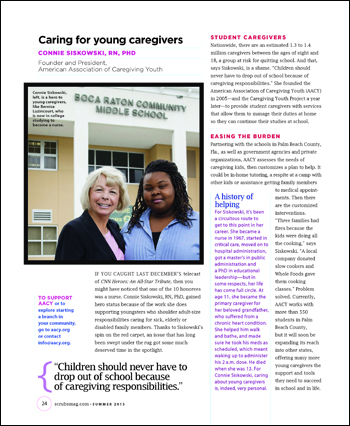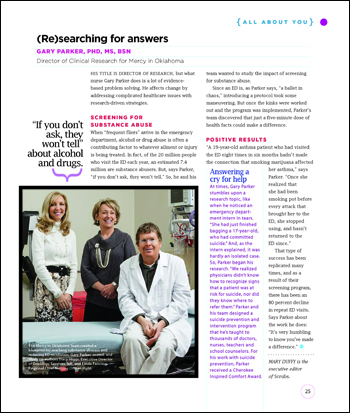Connie Siskowski, RN, PhD
Founder and President, American Association of Caregiving Youth
If you caught last December’s telecast of CNN Heroes: An All-Star Tribute, then you might have noticed that one of the 10 honorees was a nurse. Connie Siskowski, RN, PhD, gained hero status because of the work she does supporting youngsters who shoulder adult-sized responsibilities caring for sick, elderly or disabled family members. Thanks to Siskowski’s spin on the red carpet, an issue that has long been swept under the rug got some much deserved time in the spotlight.
Student caregivers
Nationwide, there are an estimated 1.3 to 1.4 million caregivers between the ages of 8 and 18, a group at risk for quitting school. And, that says Siskowski, is a shame. “Children should never have to drop out of school because of caregiving responsibilities.” She founded the American Association of Caregiving Youth (AACY) in 2005—and the Caregiving Youth Project (CYP) a year later—to provide student caregivers with services that allow them to manage their duties at home so they can continue their studies at school.
Easing the burden
Partnering with the schools in Palm Beach County, government agencies and private organizations, AACY assesses the needs of caregiving kids, then customizes a plan to help. It could be in-home tutoring, a respite at a camp with other kids, or assistance getting family members to medical appointments. Then there are the customized interventions. “Three families had fires because the kids were doing all the cooking,” says Siskowski. “A local company donated slow cookers and Whole Foods gave them cooking classes.” Problem solved.
Currently, AACY works with over 550 students in Palm Beach County, Florida, but it will soon be expanding its reach into other states, offering many more young caregivers the support and tools they need to succeed in school and in life.
A history of helping
For Siskowski, it’s been a circuitous route to get to this point in her career. She became a nurse in 1967, started in critical care, moved on to hospital administration, got a master’s in public administration and a PhD in educational leadership—but in some respects, her life has come full circle. At age 11, she became the primary caregiver for her beloved grandfather, who suffered from a chronic heart condition. She helped him walk, bathe and made sure he took his meds as scheduled, which meant waking up to administer his 2 am dose. He died when she was 13. For Connie Siskowski, caring about young caregivers is, indeed, very personal.
To support AACY or to explore starting a branch in your community, go to www.aacy.org or contact in**@aa**.org.
Gary Parker, PhD, MS, BSN
Director of Clinical Research for Mercy in Oklahoma City, Oklahoma
His title is Director of Research, but what nurse Gary Parker does is a lot of evidence-based problem solving. He affects change by addressing complicated healthcare issues with research-driven strategies.
Screening for substance abuse
When “frequent fliers” arrive in the emergency department, alcohol or drug abuse is often a contributing factor to whatever ailment or injury is being treated. In fact, of the 20 million people who visit the ED each year, an estimated 7.4 million are substance abusers. But, says Parker, “if you don’t ask, they won’t tell.” So, he and his team wanted to study the impact of screening for substance abuse. Since an ED is, as Parker says, “a ballet in chaos,” introducing a protocol took some maneuvering. But once the kinks were worked out and the program was implemented, Parker’s team discovered that just a five-minute dose of health facts could have a positive impact.
Positive results
“A 19-year-old asthma patient, who had visited the ED eight times in six months, hadn’t made the connection that smoking marijuana affected her asthma,” says Parker. Once she realized that she had been smoking pot before every attack that brought her to the ED, she stopped using, and hasn’t returned to the ED since.”
That type of success has been replicated many times, and as a result of their screening program, there has been an 80 percent decline in repeat ED visits. Says Parker about the work he does: “It’s very humbling to know you’ve made a difference.”
Answering a cry for help
At times, Gary Parker stumbles upon a research topic, like when he noticed an emergency department intern in tears. “She had just finished bagging a 17-year-old, who had committed suicide.” And, as the intern explained, it was hardly an isolated case. So Parker began his research. “We realized physicians didn’t know how to recognize signs that a patient was at risk for suicide, nor did they know where to refer them.” Parker and his team designed a suicide prevention and intervention program that has been taught to thousands of doctors, nurses, teachers and school counselors. It’s also been incorporated in the curriculum of at least one nursing school, and it’s been replicated in hospitals around the world. For his work with suicide prevention, Parker received a Cherokee Inspired Comfort Award.
Sponsored by Cherokee Uniforms



















